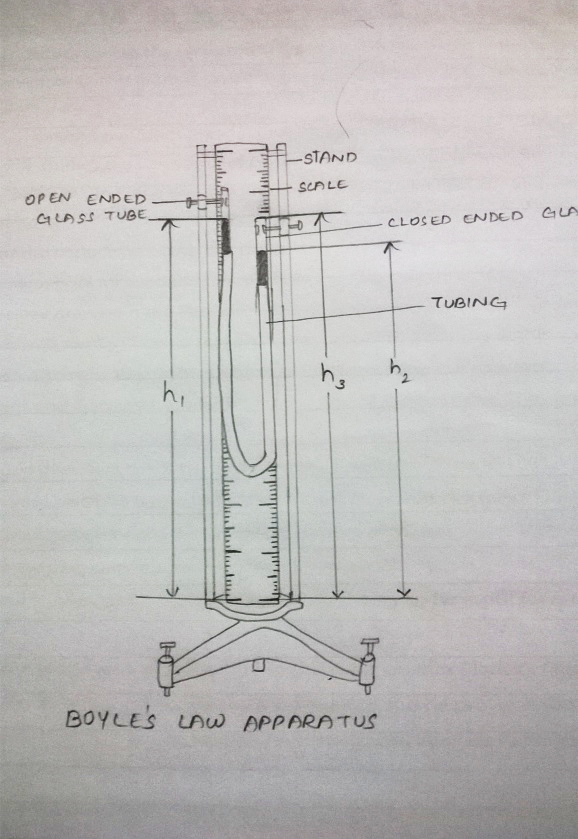Make the following table in your notebook and fill in the details.
|
S.No |
Physical quantity |
Independent / Dependent |
Measured with |
Measuring instrument’s |
||
|
Minimum |
Maximum |
Least count |
||||
|
1 |
Pressure |
|
|
|
|
|
|
2 |
Volume |
|
|
|
|
|
How to measure pressure:
-
The top point in the open end of manometer is at atmospheric pressure.
-
If the levels in both the arms are at same height, then the gas in the closed arm is also at atmospheric pressure.
-
If the level of mercury in the closed arm is lower than the open end, then the gas in the closed arm is at higher pressure than the atmospheric pressure (PA).
How to measure Volume:
-
The volume of gas is enclosed in a (almost) cylindrical tube. (Neglect the curvature of the closed tube and the surface of mercury).
-
Hence the volume is . Here h = \(h_{3}\)- \(h_{2}\) (as shown in figure given below)
-
As Cross section is constant and volume is proportional to h, take readings for volume in terms of h.

-
Measure the atmospheric pressure (\(P_{0}\)) using a barometer, if available. Else take it as 76 cm/Hg.
-
Measure \(h_{1}\), \(h_{2}\) and \(h_{3}\) and note in the following tabular form.
Table III : Measurements to be taken
\(P_{0}\) = _____________cm/Hg
|
|
Measure |
Pressure |
∝ Volume |
Calculate |
||||
|
S.No |
\(h_{1}\) (cm) |
\(h_{2}\) (cm) |
\(h_{3}\) (cm) |
Δ = \(h_{1}\)- \(h_{2}\) (cm) |
\(P\)= (\(P_{0}\) + Δ) (cm/Hg) |
\(L\)= \(h_{3}\)- \(h_{2}\) (cm) |
1/\(L\)(cm-1) |
\(P\) × \(L\) (cm2) |
|
1 |
|
|
|
|
|
|
|
|
|
. . |
|
|
|
|
|
|
|
|
|
10 |
|
|
|
|
|
|
|
|
|
Mean of \(P\) × \(L\) |
|
|||||||
|
Standard Deviation of \(P\) × \(L\) |
|
|||||||
-
Adjust the height of the open end of the manometer to change the pressure. This will result in the change of the volume air in the closed end. Note down \(h_{1}\),\(h_{2}\) and \(h_{3}\) in the table. (Alternatively, the height of the closed end may also be varied)
-
Repeat the measurement for different values of pressure.
-
Now calculate the Pressure, Volume and Calculate columns in the table.
-
Plot the following Graphs -
-
Pressure ( \(P\)) vs - Volume ( \( 1 \) \(/\) \(L\))
-
Pressure ( \(P\)) vs - Volume ( \(L\))
-
Perform the least square fitting of the data in graph A to a straight line. Interpret the meaning of the slope and the intercept.